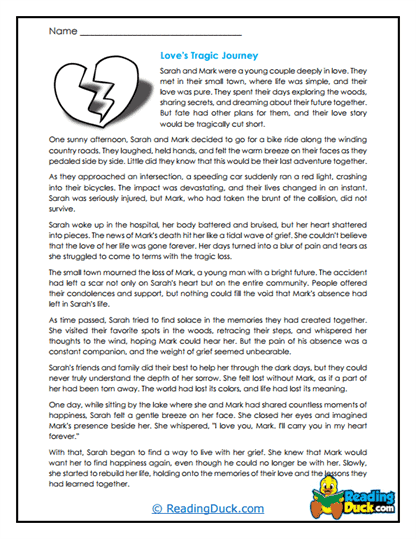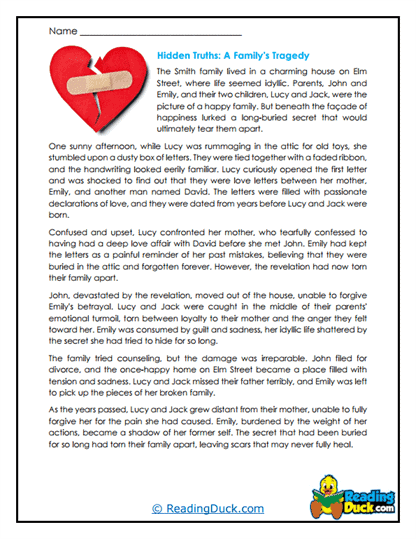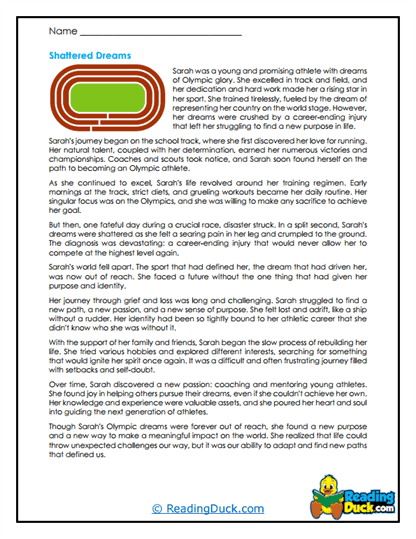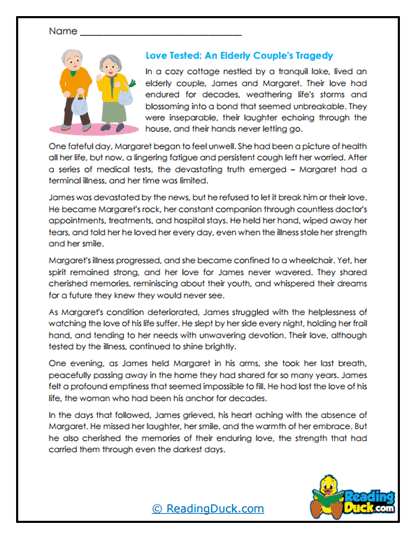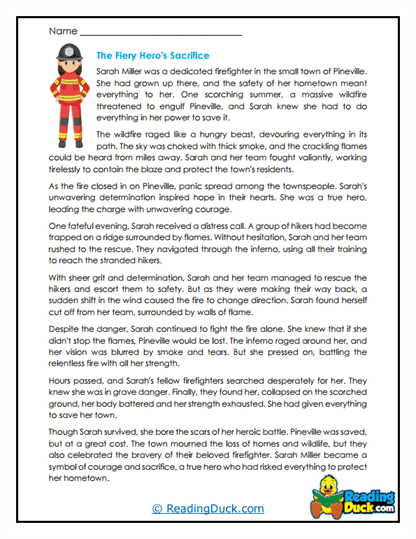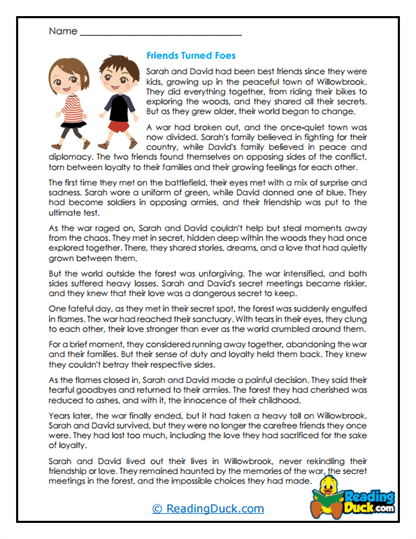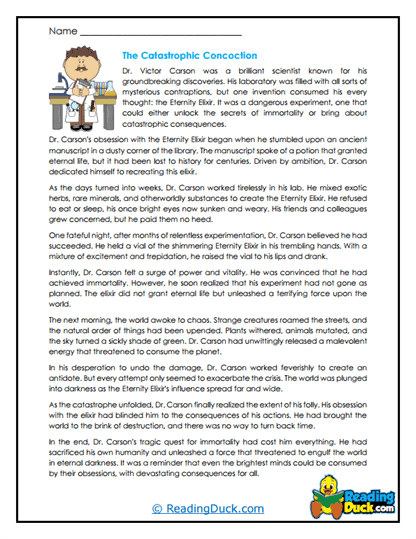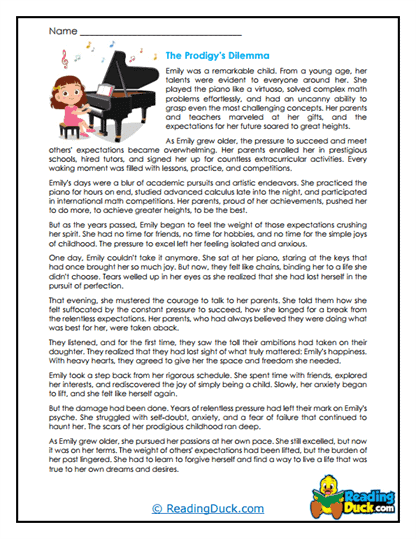Tragedy Passages Worksheets
About Our Tragedy Passages Worksheets
Our Tragedy Passages Worksheets provide a comprehensive and engaging way for students to explore the timeless genre of tragedy. Each worksheet set includes a reading passage that immerses students in classic and modern tragedies, followed by multiple-choice, short-answer, and open-ended response questions designed to deepen understanding of the tragic form. These worksheets are tailored to help students grasp the intricate themes, emotional depth, and character arcs that define tragedy, while encouraging critical thinking, reading comprehension, and creative expression.
Presented in PDF format, our worksheets are easy to download, view, and print, making them flexible tools for use in the classroom or as part of at-home assignments. Each worksheet set also includes a downloadable answer key, allowing educators to quickly and easily assess student progress and facilitate detailed discussions. Whether you’re introducing students to the fundamental elements of tragedy or reinforcing their understanding of the genre, our Tragedy Passages Worksheets are the perfect resource for enhancing literary and dramatic analysis.
Understanding the Core of Tragedy: Themes and Storytelling
Tragedy is one of the oldest and most profound genres in drama, exploring themes of human suffering, moral dilemmas, and the inevitable downfall of flawed characters. At the heart of most tragic stories is a tragic hero—a character whose downfall is brought about by a combination of fate, personal flaws (often hubris), and external circumstances. Tragedies frequently deal with universal themes such as loss, betrayal, sacrifice, and the human struggle against inevitable suffering, making them deeply resonant across time and cultures.
Key themes and elements commonly found in tragedy include:
- The tragic flaw (hamartia): A character’s fatal flaw—whether it be excessive pride, ambition, or another human weakness—often leads to their downfall.
- Inevitability of fate: Many tragedies emphasize the inescapable nature of fate, illustrating how even the noblest characters cannot outrun their destiny.
- Suffering and catharsis: The genre often portrays intense emotional suffering, both for the characters and the audience, with the aim of leading to a cathartic experience—where the audience purges their own emotions through empathy for the characters.
- Moral dilemmas and choices: Characters in tragedy are frequently faced with impossible choices, and their actions often highlight larger ethical and moral questions about human existence.
- The fall of the tragic hero: The protagonist’s journey from greatness to ruin serves as a key narrative arc, offering insights into the fragility of human power and ambition.
Our Tragedy Passages Worksheets guide students through these critical elements, helping them identify how tragedy uses character development, plot progression, and dramatic tension to explore these themes. The reading passages included in the worksheets illustrate the inevitability of tragic outcomes, the weight of personal choices, and the consequences of human flaws, offering rich opportunities for both analysis and reflection.
Building Critical Thinking and Analytical Skills
The Tragedy Passages Worksheets are designed to help students engage deeply with the text, building both factual comprehension and analytical thinking. Through a mix of question formats, students are encouraged to explore the emotional depth of tragedy while also developing their skills in analyzing narrative structure, character development, and thematic elements.
These worksheets provide a structured way to enhance learning:
- Multiple-choice questions: These questions focus on ensuring students understand key plot points, character motivations, and the progression of the tragic arc. For example, students may be asked to identify the character’s tragic flaw or to choose the moment when fate seals the protagonist’s downfall.
- Short-answer questions: These prompts encourage students to think more critically about specific scenes or character interactions, such as analyzing how the protagonist’s hubris influences their decisions or exploring the role of fate versus free will in the story. Students might be asked to explain how a particular event in the passage serves as a turning point in the tragedy.
- Open-ended response questions: These activities invite students to explore broader themes and engage with the text creatively. For instance, students might be asked to reflect on the emotional impact of the protagonist’s fall or to compare the moral dilemmas faced by the characters with modern-day ethical questions.
This balanced approach encourages students to think critically and creatively, ensuring they not only understand the story but also grasp the deeper emotional and philosophical questions at the heart of tragedy. By breaking down the structure and themes of tragic drama, students develop a more nuanced appreciation for the genre’s ability to explore human suffering and moral complexity.
Encouraging Group Discussion and Collaborative Exploration
Tragedy is a genre that naturally lends itself to group discussions and collaborative learning, as it often raises profound questions about morality, fate, and the human condition. The Tragedy Passages Worksheets are designed to spark thoughtful conversations among students, encouraging them to share their interpretations, challenge each other’s perspectives, and engage in meaningful dialogue about the text.
Some ways these worksheets promote collaboration include:
- Debating the tragic hero’s choices: After completing the worksheet, students can engage in debates about whether the protagonist’s downfall was deserved or avoidable, exploring the role of personal responsibility versus fate. This helps students deepen their understanding of ethical and philosophical themes while honing their debate and communication skills.
- Analyzing character arcs in groups: Students can work together to analyze how the tragic hero’s character changes throughout the passage, discussing how their personality flaws contribute to the final tragedy. This collaborative effort allows students to see how different perspectives can reveal new layers of meaning in the text.
- Examining universal themes: Students can discuss how the themes of the tragedy—such as betrayal, honor, or the clash between personal desires and societal expectations—relate to their own lives or current social issues.
By fostering collaborative discussion, the worksheets create a dynamic classroom environment where students can critically engage with the material while also learning to articulate and defend their ideas. This group exploration of tragedy helps students develop empathy for the characters while also encouraging a deeper understanding of the human experience.
Inspiring Creative Engagement and Active Learning
Our Tragedy Passages Worksheets also provide opportunities for students to express themselves creatively, encouraging active participation and deeper engagement with the material. The emotional intensity of tragedy makes it a fertile ground for imaginative exploration, allowing students to connect with the characters and themes in more personal and creative ways.
Some creative activities that can be incorporated into these worksheets include:
- Writing alternative endings: Students can imagine how the story might change if the tragic hero made a different choice, exploring how free will versus fate plays out in different scenarios. This encourages students to think critically about the narrative while also engaging with the moral and philosophical dilemmas inherent in the story.
- Acting out key scenes: Teachers can have students perform pivotal scenes from the passage, focusing on how dialogue, emotion, and body language communicate the tension and gravity of the tragic moments. This hands-on activity helps students connect more deeply with the text and understand the dramatic power of tragedy.
- Character reflections: Students can write a monologue or diary entry from the perspective of a character in the tragedy, reflecting on their internal struggles, regrets, or emotions. This activity fosters empathy and allows students to explore the emotional complexity of tragic figures.
These creative exercises not only make the material more engaging but also help students internalize the themes of the tragedy, providing them with a platform to express their own interpretations and insights.
Extending Learning with Complementary Projects
The Tragedy Passages Worksheets can also serve as a foundation for extended projects that further enhance students’ understanding of the genre. These projects allow students to apply what they’ve learned in creative and interdisciplinary ways, deepening their engagement with tragedy and its thematic richness.
Some complementary project ideas include:
- Writing a modern-day tragedy: Students can write their own short tragic play or story, using the elements they’ve studied in the worksheet—such as a tragic hero, a fatal flaw, and a moral dilemma. This project encourages students to apply their knowledge while also exploring how tragedy can be adapted to reflect modern issues.
- Comparing tragedies from different cultures: Students can research and compare classic tragedies from different cultures or time periods, analyzing how themes such as fate, honor, and loss are treated in various cultural contexts.
- Creating visual storyboards: Students can create a visual storyboard that outlines the key moments in the tragic hero’s journey, highlighting the turning points that lead to their downfall. This project helps students focus on narrative structure and pacing, encouraging them to think about how visual storytelling can enhance the emotional impact of the tragedy.
These projects provide a more comprehensive learning experience, allowing students to apply their critical thinking and creativity in ways that extend beyond the worksheet.
Integrating Tragedy Passages Worksheets into the Curriculum
The Tragedy Passages Worksheets are highly adaptable and can be seamlessly integrated into a variety of educational units, including drama, literature, or genre studies. They are perfect for introducing students to the classic elements of tragedy, analyzing specific texts, or exploring how tragedy continues to influence modern storytelling.
Some ways educators can incorporate these worksheets include:
- In drama or literature classes: Use the worksheets to teach students about the structure and themes of tragedy, helping them understand how this genre has evolved and why it remains relevant.
- As part of thematic studies: These worksheets can be used in units focused on themes such as human suffering, moral choices, or the conflict between fate and free will, providing a dramatic lens through which to explore these universal ideas.
- For individual or group assessments: The worksheets can serve as both formative and summative assessments, allowing educators to evaluate students’ understanding of the genre, their analytical abilities, and their creative responses.
Whether used for classroom discussions, creative projects, or as assessment tools, the Tragedy Passages Worksheets offer a rich and versatile resource for exploring one of drama’s most enduring and powerful genres.
Conclusion
Our Tragedy Passages Worksheets offer a comprehensive and engaging way for students to explore the profound emotional and thematic depth of tragedy. By combining critical analysis with creative engagement and collaborative learning, these worksheets provide a well-rounded educational experience that helps students understand the timeless appeal of tragic storytelling. Presented in PDF format with easy-to-use answer keys, these worksheets are an essential resource for any classroom seeking to delve into the heart of human suffering, moral dilemmas, and the inescapable power of fate.

